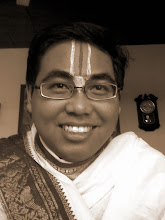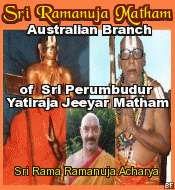 The Balinese Padmabhuvana-mandala
The Balinese Padmabhuvana-mandalaPurve tu isvaradeva agneyyam tu mahesvarah Daksine bhagavan brahma nairittyam rudra eva ca Pascime tu mahadevo vayavye sankaras tatha Uttare vishnudevata aisanyam sambhur ucyate
Isvara is the Lord of Eastern Direction, Mahesvara of South East, Brahma of South, Rudra of South West, Mahadeva of West, Sankara of North West, Vishnu of North, and Sambhu of North East.
The Supreme Deity of their sects was placed at Madhya, the center, as the source of other eight manifestations. So next we find, madhye padma sivadeva, at the center of this lotus-like mandala of the world (Padma-bhuvana-mandala) is Lord Siva. The Nava-devata-stuti then explained the characteristic of each devata as showed by Their Astram or mystical weapons. The Astrams symbolize The Nava-devatas spiritual potencies.
Isvarapurve vajram tu dhupagneya mahesvara danda brahma daksine ca nairityam rudra moksalam pascime pasa mahadeva vayavyam ankus sankaram gada visnuttare desa aisanyam sambhu trisulam padma madhya sadasiva adhah sivas ca cakras ca
Lord Isvara of Eastern direction with Vajra weapon, Mahesvara with burning dhupam, Brahma with dandam/rod, Rudra with moksalam/pestle, Mahadeva with pasa/rope, Sankaram with ankusa, Vishnu with gada/club, Sambhu with trisula, and at the center is Sadasiva with padma/lotus and cakra/fiery wheel.
Very interesting, the dhyana-sloka of Nava-devata stuti and Asta-maha-bhaya stotram (we’ll discuss it latter) describes Madhya-dese Siva, with traditional attributes of Vishnu-Narayana according to Puranic-Agamic presentation, the padma and cakra. This stuti was chanted by all Balinese Saiva, Bauddha, and Vaishnava high priests. So all the three sects of Bali install “A Certain Deity” to presides at the centre of mandala, with His special characteristic of padma and cakra. Then the Saiva called this Deity “Siva” or Sadasiva.
 Table of The Abodes of Maha-bhayas, The Supreme Terror - Destroyer of All Enemies (click for larger view)
Table of The Abodes of Maha-bhayas, The Supreme Terror - Destroyer of All Enemies (click for larger view)Nusantara Tantric sadhana also characterized by continuous chanting (japa) of bija-mantras, matrukas (syllables), and some sounds without meaning (we found the same in many Mahayana Dharanis). So sometimes, even a mantra was chanted to glorify the devata-without mentioning the complete name, only first syllables of it. For example in Nusantara Saiva tradition, they worship Lord Siva in His five features of Sadyojata, Bamadeva, Tatpurusha, Aghora, and Ishana. In Vedic tradition we can find these five forms mentioned in Mahanarayana Upanishad of Yajurveda. There are many dhyana-sloka and mantras for worshipping each of these five forms, but the Balinese texts sometime just says SAM namo namah instead of SAdyojataya namo namah. So, by this way we find formulation of what they called Pancha Brahma Bija: SAM-BAM-TAM-AM-IM. The Nusantara Saivas prefer to chant a unique form of SAM-BAM-TAM-AM-IM NAM-MAM-SIM-VAM-YAM than the common Pancaksara Sivamantra “Om namah sivaya”. But in Nusantara Hindu practices, these Saivite formulas almost lost their sectarian nature in Trinatha cult of Nusantara. BAM and AM become bijas to denote Brahma and Vishnu of the Trinity respectively. The SAM-BAM-TAM-AM-IM NAM-MAM-SIM-VAM-YAM was famous as Dasaksara (Ten Syllables) and hold as highly powerful by all sects of Nusantara Hindu.
In Padma-bhuvana-mandala each of these ten syllables was installed at nine directions. SAM-East, BAM-South, TAM-West, AM-North, NAM-Southeast, MAM-Southwest, SIM-Northwest, VAM-Northeast, IM-YAM-Center. Since Bali was arranged as a three dimensional Padma-bhuvana-mandala, then to absorb this island’s spiritual power we may use these Ten Syllables.
By mystical process of invoking the energies of these nine cardinal devatas one may get the spiritual power to defeat all enemies (physical enemies, sickness, mental disturbances, bad fortune, etc.). Through the medium of fire, water, and mantras one may attains many highly beneficial effects, both materially and spiritually, by absorbing and installing the energies mystically in various parts of his/her body.
Fire is ritualistically present in the form of Homatraya. This is a simplified form of Homayajna or Vedic-Agamic fire sacrifice in the form big dipam (oil lamp). The Homatraya considered as the representative and visible form of Trinatha, The Hindu Trinity of Brahma, Vishnu, and Siva. The Trinity then manifest as the nine cardinal devatas as represented by one big dipam at the center and surrounded by eight smaller dipams. One should meditate on this fire as the most powerful fiery divine energy and burns all kind of enemies; spiritual, mental, and material. This is the form of sacred OM with its Ardhacandra/ardhamathra, Nada, and Bindu shining effulgently on a fully blooming lotus, The Heart. Nine devatas were invoked in Their wrathful forms called Maha-bhayas, Highly Terrorizing, creating indescribable fear in all enemies’ heart.
 Bigger Homatraya-agni-kundam with various offering
Bigger Homatraya-agni-kundam with various offering Homatraya-agni-kundam shining in the night
Homatraya-agni-kundam shining in the night OM (in Balinese alphabet), shining jewel inside the lotus
OM (in Balinese alphabet), shining jewel inside the lotusAfter “fire meditation”, the aspirant was guided to perform the next step by accepting holy water bath. A protective and benedictory hymns called Maha-bhaya stotra was chanted along this process. This stotra was arranged in the form of what we call dig-bandha-mantra, the shield to protect the aspirant from all directions. The Maha-bhaya-devatas were glorified as Sarva-satru-vinasa, The Supreme Terror who destroys all kind of enemies. The essence of Maha-bhayas then projected into holy water for bathing the aspirant. This was considered as spiritual bath with the anointment of The Maha-bhayas as presented by mantras, their bijaksaras, and flow of holy water. The aspirant meditates on the shower of holy water as the flow of energies, entering through a small mystical door on the top of his head (brahma-randhra) and imbibes his whole body with spiritual power. This part gave the ritual its name, Mandi Weda, a type of abhiseka, ritualistic bathing. Mandi means bathing and Balinese used to call all type of mantras as Weda. So this is a ritual of sacred bathing accompanied by chanting mantra. After this ritual, energies of The Maha-bhayas and Their mystical present has been installed in various bodily parts of the aspirant.
 A Balinese couple accepts Mandi Weda from Highpriest
A Balinese couple accepts Mandi Weda from Highpriest






























Hare Krishna Prabhuji! Very informative and deep. Thank you for taking the trouble to research and share these treasures with us all here. May Sri Krishna's and Guru's blessings continue to guide you always. Haribol!Om Shanti (3x)!
ReplyDeletereally nice info.. i love bali
ReplyDeleteI would really like your post ,it would really explain each and every point clearly well thanks for sharing.
ReplyDelete